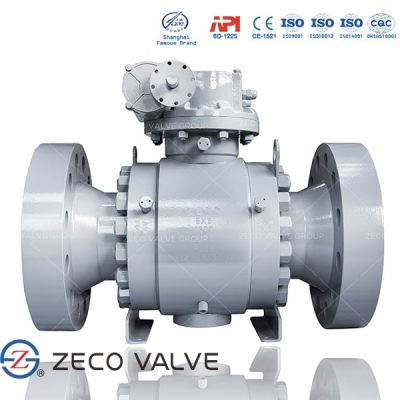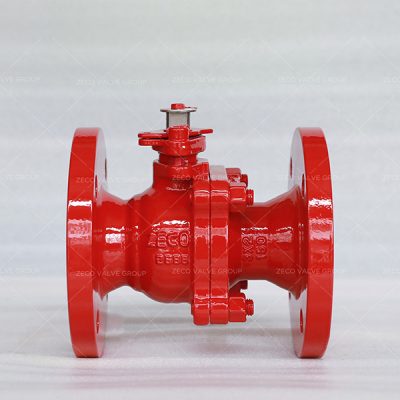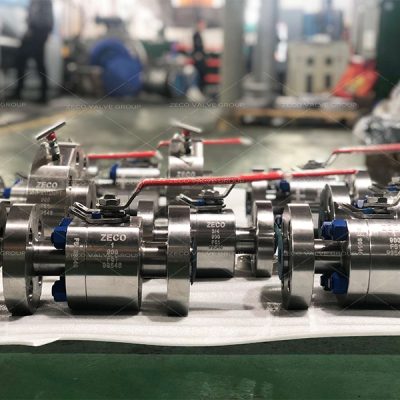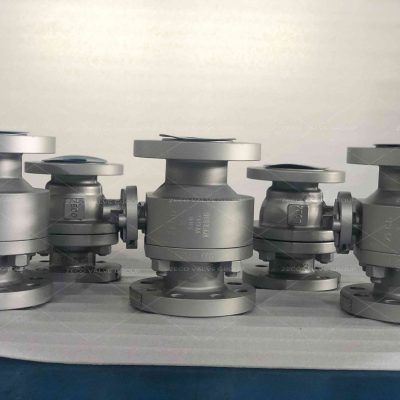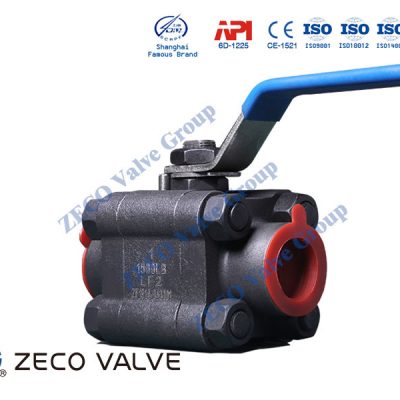Employing the latest in processing technology and manufacturing automation, ZECO Valve offers high quality metal seated ball valves for service conditions where soft seats will simply not perform. Whether it is temperature or abrasion driven, ZECO Valve offers a broad range of hard coatings designed for optimal performance.
What is Metal Seat Ball Valve?
Metal Seated Ball Valve is manufactured for high temperature up to 540℃ (may be higher based on the material of body and trim) or abrasion resistance. Metal Seated Ball Valves are Zero leakage (bubble tight seal). Metal Seated Ball Valve is also called metal to metal ball valve, as the seat and ball are made from metal.
For metal seated ball valve, the seat ring and ball are precisely machined, coated by high velocity oxygen fuel(HVOF) coating process and lapped to match ball, creating a positive seal for bubble-tight performance. Metal seated trunnion ball valves have many advantages such as excellent corrosion & wear resistance, tight shut-off, smooth control, low torque, wide temperature & pressure range, as well as stability under pressure. Metal seated ball valve provide long service life with outstanding fugitive emissions performance and low operating torques in even the toughest applications.
Minimal moving parts with flawless execution make our floating & trunnion ball valves a more suitable choice for severe applications. Full rotational surface lapping of slurry resistant scraper seats makes our metal seat ball valves the most dependable sealing valves available – at an unparalleled price point.
Specifications of Metal Seat Ball Valve
- Design Standard: API 608, API 6D, ASME B16.34
- Size Range: 2” to 36” *
- Pressure Range: Class 150 – 2500 *
- End Connections: Flanged RF & RTJ, Butt Weld *
- Inspection and Testing: API 598 test with no visible leakage
- Flanged End Dimensions: ASME B16.5 (≤24”), ASME B16.47 Series A or B (>24”)
- Butt Weld End Dimensions: ASME B16.25
- Socket Weld End Dimensions: ASME B16.11
- Threaded End Dimensions: ASME B1.20.1
- Face to Face Dimensions: ASME B16.10
- Pressure-Temperature Ratings: ASME B16.34
Surface Coatings for Metal Seated Ball Valve
Unlike surface treatment methods whereby the existing surface is changed by diffusion, in surface coating an outer layer of new material is generated on the surface. The following types of surface coating methods are available in the Habonim metal seated range; chromium carbide with nickel chrome binder (Cr3C2), tungsten carbide with cobalt binder (WC-Co), and stellite welding.
Stellite
Applications:
- Liquid + Gaseous media with partially entrained particles / solids (moderate operating cycle)
- Excellent wear resistance / good corrosion resistance
- Wide temperature range
A cobalt-based stellite coating on valve ball and seat provides excellent mechanical wear resistance, with good corrosion resistance at temperatures up to 538˚C (1000˚F). The Stellite is applied by a Plasma Thermal Arc (PTA) method. Most stellite alloys are cobalt based with elements of Chromium (Cr), Carbon(C), Tungsten (W) and Nickel (Ni). Stellite is broadly used in the pulp and paper industry, as well as in refining applications, such as catalyst handling and hydrocracker processes.
WC-Co (Tungsten Carbide)
Applications:
- Liquid + Gaseous media with partially entrained particles / solids (high operating cycles)
- Excellent abrasion resistance / good corrosion resistance
Tungsten Carbide with a cobalt binder coating applied by HVOF techniques similar to Cr3C2.WC-Co coating applied mainly to 400 series martensitic stainless steel results with micro-hardness as high as 72HRC. This coating resists cryogenic temperature down to -196˚C (-320˚F) and high temperatures up to 538˚C (1000˚F). WC-Co is a wear resistance anddense coating with chemical resistance to sulphur environment on Nickel based alloy.
Cr3C2 (Chromium Carbide)
Chromium Carbide with nickel chrome binder applied by a High Velocity Oxygen Fuel (HVOF) gun creates a 0.3mm hard outer layer. Cr3C2 coating applied to high strength steels, results in a micro-hardness of up to 68HRC. This coating resists cryogenic temperatures down to -196˚C (-320˚F) and high temperatures up to 815˚C The valve maximum temperature is 650°C. All the temperatures above 650°C refer to the coating or bolts performance only (1500˚F). This multipurpose wear resistance coating is used extensively in the power generation, refining and hot catalyst handling services. Its limitations are in wet sulphur or chloride environments where sulphuric acid can form and attack the coating.
Coating Testing
- Bond Strength Tensile Test
- Shear Strength Tensile Test
- Macro Hardness Rockwell Test
- Porosity Determination
- Bond Line Contamination
- Abrasion Wear Testing
Features of Metal Seat Ball Valve
- Unique, the metal seated ball valve with patented single-seat ball valve design. It has a flat spring set acting through a hard-faced bearing against the bottom ball shaft which provides sufficient initial ball-seat load for valve tightness, even at low delta P.
- Metal seated ball valve proven in qualification tests and field operation to be solids–proof, even for the toughest applications on slurry service with solids particles.
- Tightness rates: Allowable leakage rate at full Delta P: ASME/ FCI 70-2 Class VI/V. Tighter shutoff available upon request. The leakage rate also can be customization from end-user request
- The metal seated ball valve with standard extension bonnet/stem, whose design base on the different temperature range.
- Uni-directional or bi-directional sealing
Metal Seat Ball Valve vs Soft Seat Ball Valve
When selecting a ball valve, you’re faced with a myriad of options. Materials of construction, the proper size, and the right design (1, 2, or 3 pieces, V-port, double block, bleed, etc.) are all critical pieces to the puzzle. Just as important is the seat type you’ll select.
Completely understanding your process conditions is the first step to selecting a seat for your valve. Will the fluid be corrosive? Contain abrasive particulate? Be at high temperatures or pressures? Require bubble-tight shut-off? Once you know these things, the choice is clear.
Soft seats are generally made of thermoplastic materials like PTFE. They’re great for applications where chemical compatibility is important, and where the tightest seal is key.
However, soft seats are not recommended for process fluids that are dirty, or abrasive. Soft seats can break down in these conditions, causing the valve to leak.
The primary advantage of metal seated valves over soft seated valves is their ability to withstand high temperatures and severe service conditions. Metal seats can endure severe flashing, hydraulic shock, abrasive process fluid, and high temperatures up to and exceeding 1,000° F. They are also ideal for high erosion or corrosion applications.
Metal seats can be hardened by coatings like ultrasonic spray coating, satellite hard facing, chromium carbide and tungsten carbide.

